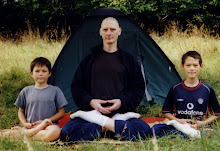A written vow I made to myself in 1983 to accomplish the translation of Shobogenzo into English without counting the personal cost -- in combination with some very bad decisions I took along the way -- brought me in its wake, amid a variety of lesser disappointments, two significant episodes of heartbreak. The first was in 1984, the second in 1997. If history repeats itself in a 13-year cycle, 2010 will not be a year for me to relish.
In one respect, I am fortunate to have had my heart twice broken, because this has given me redoubled opportunities to investigate in recurring cycles what the six states of cause and effect, the six samsaric realms, really are. Traditionally they are described as the states of (1) beings in hell (naraka in Sanskrit); (2) hungry ghosts (Skt: preta); (3) angry demons (Skt: asura); (4) animals (Skt: tiryagyoni); (5) humans (Skt: manusya); (6) gods (Skt: deva).
I have continued to experience these six states, cycle after cycle after cycle, in the ten years since I trained at INPP Chester as a developmental practitioner i.e. one who helps people (mainly children) towards better integration of aberrant primitive reflexes. As a result of my own samsaric cycling, although I can be very slow on the uptake when it comes to practical matters, even I have been unable, in the end, not to see a parallel between progression through the six samsaric states and developmental progression through the primitive reflexes.
For a baby to experience the white or blue of fear paralysis is one thing. For a baby to experience the red flush of a full-blown Moro reflex panic, is another thing. But for an adult to be caught in the grip of these two mutually opposing fear responses, as they fight it out with each other for dominance, is hell itself (1).
An aberrant tonic labyrinthine reflex (TLR) manifests itself in the disoriented state of the hungry ghost (2), who knows that he badly wants something but, without a properly functioning vestibular system, is unable to discern clearly what it is or to direct himself towards it.
The asymmetrical tonic neck reflex (ATNR) , as sometimes manifested in temple statues of guardian deities, is a pattern I know well from a past life as a winner of karate tournaments: The face is turned towards an arm that is outstretched in a long punch, while the opposite fist is brandished triumphantly behind the back of the head, arm flexed, bicep bulging. The mouth is open and emanating from the bowels is a loud yell -- Aaaagh! It is the pose of the asura (3), an angry, god-defying demon. The ATNR is an asymmetrical pattern that opposes the symmetrical pattern of the Moro/TLR. It arises out of fear/imbalance, and at the same time it is a manifestation of strong intention, bordering on anger, that breaks a person out of the frozen grip of fear and into vigorous action.
Inhibition of the symmetrical tonic neck reflex (STNR) is, in postural terms, the difference between monkeys and the like (4) and human beings (5). Infants and monkeys who haven't fully inhibited this reflex still shuffle around on their bottoms, or go on all fours, or walk not quite upright with hips and knees still partially flexed, their knuckles dangling ape-like towards the ground. Only those who have fully inhibited this reflex are able to stand fully upright.
Integration of primitive and postural reflexes brings with it greater possibilities of conscious control, of consciousness of freedom. But this kind of consciousness all-too-easily becomes disconnected from the underlying energetic/reflex substrate in which it is truly grounded, in which case consciousness of human freedom all too easily turns into the ungrounded, precarious, airy-fairy state of a celestial being (6)... and so the cycle continues.
Quod Erat Demonstrandum.
Master Dogen wrote, in Shobogenzo chapter 4, Ikka no Myoju, The One Bright Pearl:
"Do not worry about falling or not falling into the six states of cause and effect. They are the original state of being right from head to tail, which is never unclear, and the bright pearl is its features and the bright pearl is its eyes."
If it is not too pretentious of me to try to echo Master Dogen's words with some words of my own:
From my own ab-errant broken-hearted path through life, which has led me into sitting-zen, into Alexander work, and into investigation of the vestibular reflexes, I am learning that it is not necessarily at the end of the developmental process that true value lies. Rather, it may be just in the developmental process itself that true value lies.
It may be, in short, that the pearl is in the lotus.
OM. MANI PADME. HUM.
Thursday, 14 February 2008
Subscribe to:
Post Comments (Atom)

1 comment:
The face is turned towards an arm that is outstretched in a long punch, while the opposite fist is brandished triumphantly behind the back of the head, arm flexed, bicep bulging. The mouth is open and emanating from the bowels is a loud yell -- Aaaagh! It is the pose of the asura (3), an angry, god-defying demon.
I catch myself doing this when I am stretching or yawning and often remember of this post.
Keep on keeping on!
Jordan
Post a Comment